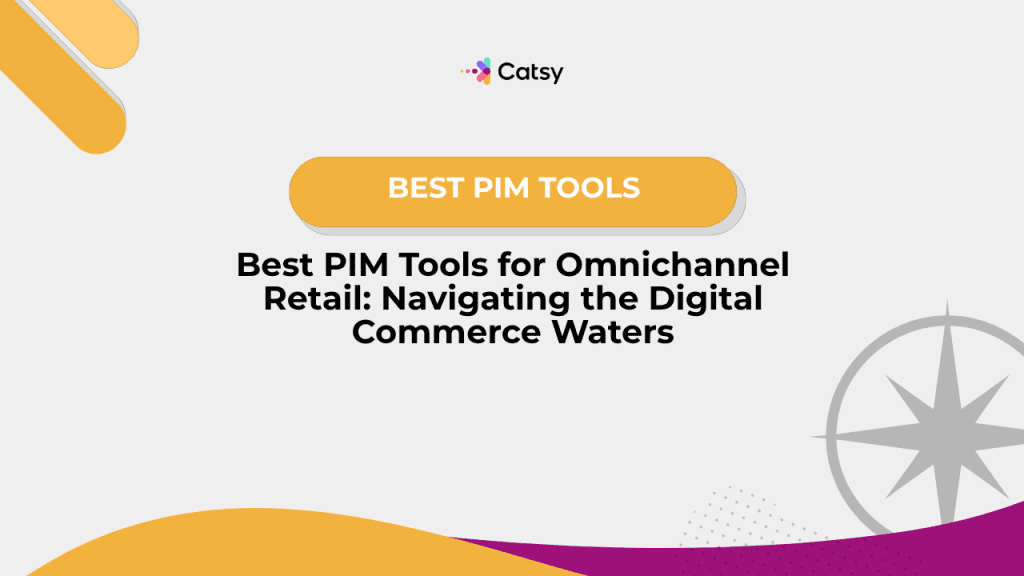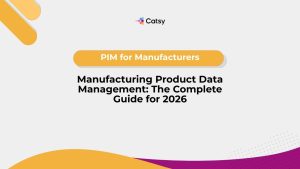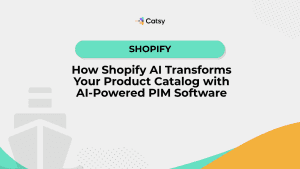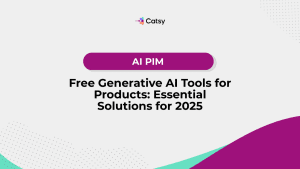Best PIM Tools for Omnichannel Retail: Navigating the Digital Commerce Waters
In the ocean of today’s digital commerce, you may find yourself sailing through choppy waters. Your customers expect a seamless experience whether they’re browsing on mobile, shopping in a brick and mortar store, or checking you out on social media.

Table of Contents
- Setting Sail: Understanding PIM in Omnichannel Retail
- Charting Your Course: Why PIM is Essential for Modern Retailers
- Navigation Tools: Key Features to Look for in PIM Solutions
- Top PIM Platforms: Your Fleet of Options
- Plotting Your Route: Implementation Strategies
- Smooth Sailing: Best Practices for PIM Success
- Future Horizons: Emerging Trends in PIM Technology
- Key Takeaways
- FAQ
What You Will Learn
- How to navigate the complex waters of Product Information Management (PIM) systems
- The essential features that make a PIM solution “seaworthy” for omnichannel retail
- A comprehensive review of the top PIM platforms that are currently anchored in the market
- Strategic approaches to implementing PIM systems without running aground
- Best practices to keep your product data sailing smoothly across all channels
- Future trends that will shape the PIM landscape on the digital horizon
In this Article
1. Setting Sail: Understanding PIM in Omnichannel Retail
In the ocean of today’s digital commerce, you may find yourself sailing through choppy waters. Your customers expect a seamless experience whether they’re browsing on mobile, shopping in a brick and mortar store, or checking you out on social media.
Just as a skilled captain needs reliable navigation instruments, retailers need robust product information management (PIM) systems to steer data across multiple channels successfully.
Your PIM is your digital compass. It centralizes all of your product-related information in one unified harbor. Think of it as your ship’s manifest. It’s a single source of truth that contains everything from your basic product info to your complex tech specs.
a. The Omnichannel Challenge
Modern retail has evolved! Single channel operations have made way for complex, omnichannel ecosystems. As a retailer, you must manage product info across dozens of touchpoints. Consider your e-commerce websites, your mobile apps, social media platforms, physical stores, third-party marketplaces… it’s a lot!
Without a proper PIM system, managing product data across these channels is like trying to navigate stormy seas without the proper charts. Your information becomes scattered across different systems, leading to inconsistencies, errors, and ultimately, poor customer experiences.
b. The Business Impact
The stakes couldn’t be higher in today’s competitive retail environment. Research consistently shows that poor product data directly impacts sales performance.
Studies indicate that up to 87% of online shoppers consider product content extremely important when making purchase decisions. When your product information is incomplete, inaccurate, or inconsistent across channels, it creates friction in the customer journey. This leads to abandoned carts, returns, and lost revenue.
2. Charting Your Course: Why PIM is Essential for Modern Retailers
Just as ancient mariners relied on the North Star for direction, you need a PIM as your guiding light through the complex space of omnichannel commerce.
The benefits of implementing a comprehensive PIM solution extend well beyond data organization. A PIM solution fundamentally transforms how your business operates and competes.
a. Operational Efficiency and Cost Reduction
Implementing a PIM system is like transitioning from printed maps to GPS. It dramatically improves your efficiency and it decreases the likelihood of costly errors.
Without centralized product information management, your teams may be spending countless hours manually updating data across several systems.
A well-implemented PIM can reduce this manual update time by up to 80 percent. Rather than manually inputting descriptions, pricing, and other specs, your teams can make changes just once in the PIM. Your system will then automatically distribute this data across your connected channels.
Many retailers report ROI improvements of 200-400 percent within the first year of PIM implementation.
b. Enhanced Customer Experience
Today’s retail environment spans many channels. However, one thing hasn’t changed: the customer experience is the wind in your sails. Your customers’ experience with your brand will either propel you forward or leave you dead in the water.
A PIM system will directly impact your customers’ satisfaction, as your consumer can be assured that your product information is accurate, complete, and consistent.
Your PIM system will ensure that each customer receives the same high-quality information… regardless of how they shop. This consistency boosts trust, leading to higher conversion rates.
Retailers with comprehensive PIM systems typically see 15-25 percent improvements in conversion rates across their digital channels.
c. Accelerated Time-to-Market
Today, speed can mean the difference between riding the wave of a trend or watching it pass you by. Your PIM is a powerful tailwind that accelerates your product launches. Your data collection, validation, and distribution is more streamlined and less error-prone than with manual processes.
A modern PIM system can enable parallel workflows where different teams can work simultaneously… no more waiting for that updated spreadsheet. This streamlined approach can reduce your time to market by 40 to 60 percent. This allows you to better capitalize on seasonal trends.
Make Catsy DAM and PIM Software an Extension of Your Team
Book a Free Demo3. Navigation Tools: Key Features to Look for in PIM Solutions
Selecting the right PIM system is like choosing the perfect vessel for your journey. The features and capabilities you prioritize will determine how you will navigate the challenges you’ll face ahead.
- Data Management and Modeling Capabilities
The seaworthiness of a PIM lies in its ability to handle complexity… with flexibility. Your ideal PIM should support hierarchical product catalogs, complex attribute management, and flexible data modeling that will adapt to your unique business needs.
Look for a system that can handle various product types. These may be standalone products or complex configurable products that have multiple variants.
The platform should support unlimited custom attributes and should include automated data validation rules. Duplicate detection and data completeness storing are also important features.
- Multi-Channel Publishing and Syndication
Your PIM system’s publishing capabilities will determine how effectively you can distribute your product information across the retail sea. Advanced syndication features should support auto-formatting and optimization based on channel requirements.
Look for PIM systems that offer pre-built connectors to the top marketplaces. Look also for flexible API capabilities that allow for custom integrations. Real-time sync capabilities ensure that your updates to product info are quick and accurate across all of your channels.
- Digital Asset Management Integration
Today’s consumers are visually driven. For that reason, managing your rich media is just as important as managing your product data itself. Your PIM should include DAM (digital asset management) capabilities. Or, at the very least, if should support seamless integration with dedicated DAMs.
Essential DAM features include:
- Support for multiple file formats
- Automatic image optimization
- Image resizing
- Version control for creative assets
- The ability to associate media with product attributes and variants
- Workflow and Collaboration Tools
Managing product information across multiple channels requires coordination. Your teams and multiple stakeholders need comprehensive workflow management tools to facilitate collaboration, but should also maintain data quality and governance standards.
Look for features such as role-based access controls, automated approval workflows, task assignment and tracking, and audit trails. These document all changes to product information.
4. Top PIM Platforms: Your Fleet of Options
The PIM software landscape offers numerous solutions! Each are designed for different types of retail operations… and unique business needs! Like choosing between vessels, selecting the right PIM platform depends on your business’s specific catalog, budget, and plans for growth.
a. Enterprise-Grade Solutions
If you’re a large retailer who’s managing omnichannel waters, an enterprise-grade PIM solutions will work best for you. These systems offer the scalability you need to manage your products across global markets.
Akeneo stands as one of the flagship enterprise PIM solutions. It offers comprehensive PIM capabilities with an API-first architecture. This platform excels in handling complex catalogs with sophisticated attribute management. Workflow automation and integration capabilities are streamlined.
Salsify has positioned itself as a comprehensive product management platform. It combines traditional PIM capabilities with advanced analytics. Channel optimization features are also included. Salsify offers pre-built connectors to major marketplaces.
b. Mid-Market Solutions
Smaller, mid-market retailers need the balance to handle complex requirements but the agility to adapt quickly to changing markets.
Catsy provides robust PIM capabilities with particular strength in digital asset management (DAM) and multi-channel publishing. The platform offers excellent workflow management tools and collaboration features.
PIMcore is an open-source PIM solution that provides enterprise-grade capabilities. The platform allows for customization, and it appeals to retailers with strong technical teams.
c. Specialized Solutions
Some specific industries have unique requirements that are better served by specialized PIM solutions.
inRiver focuses heavily on manufacturing and business-to-business retail environments. This platform offers sophisticated product relationship management and complex configuration abilities.
Syndigo specializes in product content syndication and data quality management. This makes the platform very popular among retailers who distribute through extensive partner networks.
Centric PLM is wonderful for fashion retailers. It offers specialized solutions such as the ability to manage seasonal collections, size matrices, and more!
5. Plotting Your Route: Implementation Strategies
Implementing a PIM requires planning. You’ll need to chart your course before you set sail. Let’s look at the key phases of implementation and prepare for potential obstacles.
a. Pre-Implementation Planning
Before setting sail, you must plan. Conduct a thorough audit of your existing product information landscape first. Identify data sources, quality issues, and integration requirements as a whole.
Begin by mapping all of the current systems that you own that contain product information. Document the flow of that information through your organization. Then, analyze your data for completeness, accuracy, and consistency… This will inform your data cleansing strategy.
b. System Selection and Evaluation
Develop a comprehensive evaluation that considers your current needs and your plans for growth. Create a detailed requirements document that prioritizes features based on how those features impact your bottom line.
Consider the total cost of owning a PIM. This should include licensing fees, implementation costs, onboarding payroll costs, ongoing maintenance, and other factors. Your vendor evaluation should also include hands-on demonstrations, where possible.
c. Data Migration and Training
Data migration represents one of the most critical aspects of PIM implementation. Begin with comprehensive data mapping and develop a cleansing strategy that addresses quality issues. Plan your migration in phases, starting with a subset of products to refine processes before expanding.
One of the most critical aspects of PIM implementation is data migration. Start by mapping your data, then develop a cleansing strategy that addresses any quality issues you discover. Plan your migration in phases! Begin with a subset of products to refine your processes before you integrate your full catalog.
6. Smooth Sailing: Best Practices for PIM Success
Once your PIM is up and running, you’ll need to do ongoing maintenance. Like your seaworthy vessel, a properly managed PIM will continue to deliver value … and it will adapt to your unique business’s growth.
a. Data Governance and Quality Management
You’ll need to establish data governance practices; develop clear standards to define how your product information should be structured, formatted, and maintained. Regular data quality assessments will be mandatory, and you’ll need to create clear roles within your teams for the ongoing management of your data.
b. Performance Monitoring
Establish KPIs (key performance indicators) that’ll measure both your system performance and the impact on your business .Monitor the technical metrics – system response times, for instance. Keep an eye on business metrics like your time-to-market, too.
c. Integration Management
Document, document, document! As your business grows, you’ll want “cheat sheets” to help your teams add new SKUs to your catalog. Regular testing is also important – you can identify issues before they impact your customer.
d. Continuous Improvement
To be successful in PIM integration, you’ll need to embrace continuous improvement. Stay up to date on new features, monitor trends within your industry, and conduct regular reviews to check your strategy. If your system doesn’t align with your business objectives, rework your architecture.
7. Future Horizons: Emerging Trends in PIM Technology
The PIM landscape is constantly evolving. It’s driven by changing consumer expectations as well as advances in technology. Understanding these trends helps you prepare for the future… and to make informed decisions as you choose a PIM.
a. Artificial Intelligence Integration
AI is transforming PIM systems from passive data repositories into intelligent platforms.
AI is changing how PIMs work. What used to be a passive data repository is now an intelligent platform that’s ready to grow with your business.
Automated content generation can create product descriptions and other copy based on basic attributes. It can enable automatic attribution extraction from your existing images. It can even run QA checks to ensure that data anomalies aren’t reaching your customers.
b. Enhanced Personalization
In the future, PIM systems will incorporate advanced personalization capabilities. Your product information will be presented in a way that appeals to individual consumers’ behaviors and preferences. Dynamic content optimization could automatically adjust your product descriptions for you based on customer segments!
c. Immersive Technology Support
AR and VR are becoming more mainstream, and PIM systems will need to support new types of content. Virtual showrooms, 3D models, and AR applications will be mainstream, and this tech will require new approaches to data management.
Key Takeaways
To successfully navigate omnichannel retail waters, you need a robust PIM system. The critical insights from our journey reveal:
Strategic Foundation: A PIM is a strategic enabler. Your system will transform how you manage your information across all your channels… not just technical solutions.
Platform Selection: Choose a PIM platform that matches your current needs, but that leaves wiggle room for growth. Consider the integration capabilities, the vendor stability, and the total cost of ownership of your PIM.
Implementation Excellence: Success depends on thorough planning. Comprehensive data prep and effective change management will be critical, and investing in these elements will help you achieve faster results.
Ongoing Optimization: PIM systems require continuous attention. Governance practices, performance monitoring, and embracing emerging technologies are essential to maintain while also maintaining operational stability.
Retailers who master these principles will find themselves well-equipped to navigate omnichannel commerce challenges, delivering exceptional customer experiences across all touchpoints.
As you set sail through omnichannel retail waters, remember that choosing a PIM isn’t just about data. It’s about charting a course for success and growth. The right PIM will serve as your compass as you navigate toward exceptional customer experiences.
Want more tips, tutorials, and insights on product content and e-commerce operations?
Stay connected. We post regularly to help brands like yours scale smarter.
Are You Ready To streamline your product content management?

Frequently Asked Questions
Implementation timelines will vary based on your catalog complexity, and on your preparedness.
The simplest implementations might take 3 to 6 months, while complex enterprise deployments can require 12 to 18. Key factors include data quality, integration requirements, and customization needs.
A PIM focuses specifically on your product-related information as it’s used for sales and marketing purposes. MDM has a broader reach, managing customer and supplier information.
Reduced labor, fewer errors, faster time to market, and better conversion rates should be considered as you calculate your ROI. Most retailers will see positive ROI within 12 to 24 months. Many achieve 200 to 400 percent returns over three years.
Yep! Many modern PIMs support both business-to-business and business-to-consumer structures within a single platform. You can manage different catalogs, pricing structures, content variations and more with the right system. Ensure that the platform you choose supports features like customer-specific pricing, if necessary.
Data portability will vary between platforms. Most reputable providers offer comprehensive data export, but custom configurations may require rebuilding. Consider portability as you shop for a PIM that suites your business.
Advanced PIM systems include a robust suite of options for international management! Regional product variations, local compliance requirements, currency management, and more can all be maintained within your PIM. Look for platforms that support Unicode and translation workflows.
Subscribe For More Content
Sign up for monthly tips on how to drive revenue with product content.




